Solutions for Electrical Contractors eTool
Ergonomic Solutions » Lower Arm, Hands, and Wrists
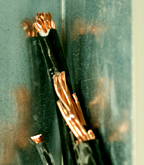
This section describes common ergonomic risk factors such as forceful pinching or pressure on the palm from a tool, which may increase the chance of injury and pain to the lower arm, hand, and wrist. General solutions that may minimize the possibility of injury and pain to these body parts are also presented.

Performing hand-intensive tasks with a bent wrist, either up and down or side to side, creates considerable stress on the tendons and their sheaths as they are bent across the harder bones and ligaments that make up the outside structure of the wrist.
Potential Hazard
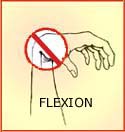
-
Bending the wrist while performing repetitive finger actions such as typing pulls the tendon over the bones and ligaments in the wrist. This creates irritation to the tendon and especially the tendon sheath, which is caught between the tendon and bone or ligament. This action creates irritation, inflammation, and eventually tendinitis or tenosynovitis.
Possible Solutions
Ergonomic Knives




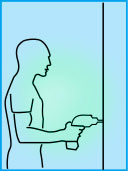
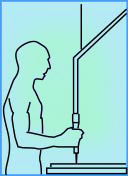
-
Train employees to keep the wrist as straight as possible while performing finger-intensive tasks. When the wrist is straight, the tendons can slide easily through the sheath.
-
Use appropriately designed hand tools so the wrist can remain straight such as ergonomic knives or bent-handled pliers.
-
Use pistol grip tools when working on vertical surfaces to maintain neutral wrist positions.
-
Use inline tools when working on horizontal surfaces to maintain neutral wrist positions.
Potential Hazard

-
Bending the wrist while performing prolonged forceful finger exertions such as forcefully sanding an object or forcefully holding a piece of slippery meat while trimming it.
Possible Solution

-
To minimize forceful finger exertions, use adjustable jigs or stands to hold work instead of holding it in the hand. Jigs or stands should hold the work securely and have a wide range of adjustability. This allows employees to place objects in a position where wrist bending can be minimized while working on the task.
Potential Hazard

-
Bending the wrist while performing tasks that require repeated rotation or twisting of the forearm, for example, using a manual screwdriver, can stretch and pull the tendon connection at the elbow. Repeated stress at this connection can cause irritation and swelling, leading to either lateral or medial Epicondylitis (tennis or golfer's elbow).
Possible Solution
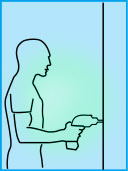
-
Use tools that allow the wrist to remain in a straight posture if manual operations must be performed. Using a "T" handle instead of a straight handle will help maintain straight wrists.
-
Use power tools instead of performing highly repetitive manual motions for example, use power screwdrivers instead of manual screwdrivers.
Exertion of high finger force, either on a prolonged or repetitive basis, can stretch and potentially fray the tendons. This kind of damage can make it difficult for the tendon to slide through the tendon sheath, which can lead to further irritation and swelling. Irritation and swelling can lead to restriction of the tendon movement through the sheath, eventually causing stenosing Tenosynovitis or Trigger Finger. Highly repetitive finger tasks which may not use great force, such as typing, can still create irritation, especially in older employees.
Contact with sharp edges of tools or bending the wrist will greatly increase the hazard associated the use of forceful finger exertions.
Potential Hazards
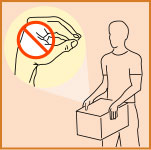
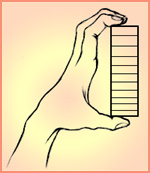
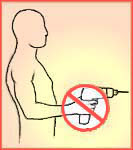
-
Pinch grips that keep the fingers relatively straight while exerting force, such as when holding the box as shown in Fig. 1, or grasping too many items at a time, Fig. 2, place the hand in a weak posture that requires excessive force exertion by the tendons in order to generate adequate finger force. Excessive force exertion can lead to fraying and pain.
-
Tools that are too large or too small require excessive finger force to hold and control.
-
Using tools or performing tasks that isolate force and repetition, such as using a single-point trigger or a mouse, may not provide adequate time for recuperation.
Possible Solutions

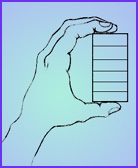

-
Avoid the use of forceful pinch grips and straight-finger pinch grips by using hand cutouts or handles when carrying boxes.
-
Use tools with appropriately sized handles if high finger force is necessary. Sized tool handles should be provided for employees who have small or large hands. The hand should be able to maintain the shape of a "C" while grasping the tool.
-
Minimize elongated grasping postures by lifting fewer items at a time.
-
Use a vice or fixture to hold items while they are being worked on instead of holding the item in the hand.
-
Use power tools to reduce the amount of finger force exerted. For example, using powered shears requires less finger force than using manual tin snips.
-
Use trigger levers instead of single-point triggers so the force exertion is spread over several fingers.
-
Activate tools using a foot pedal instead of a trigger.
-
Alternate hands to perform the task whenever possible.
-
Redesign processes to alternate tasks so muscles are not used for prolonged periods.
Potential Hazard

-
Prolonged repetitive hand work, such as typing or mousing, can damage the tendons and tendon sheaths of the fingers. These motions can cause irritation and swelling even with the low forces used during typing or mousing tasks if recuperation periods are not adequate. These repetitive motions can lead to Tendinitis, Tenosynovitis, and Carpal Tunnel Syndrome, especially if the wrist is bent.
Possible Solutions
-
Redesign processes to vary tasks for example, alternate highly repetitive tasks with those tasks that do not require high repetition.
-
Alternate hands or fingers for tasks like mousing.
-
Take frequent, short breaks, instead of less frequent, longer breaks.
-
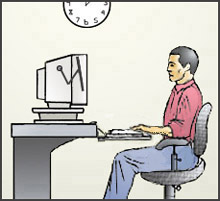
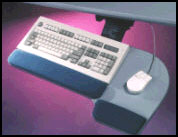
Maintain straight wrist postures by assuring proper height of the keyboard, mouse, or other working surfaces.
-
Provide a keyboard tray that is easily adjustable so straight wrist postures can be maintained.
-
The work surface may need to be lowered to keep the operator's arms in a comfortable position. This can be achieved by installing a keyboard extender or tray.
-
The hand and arm have several areas, such as the sides of the fingers, palm, and bottom of the forearm, where nerves, blood vessels, and tendons are close to the surface and unprotected.
Potential Hazard

-
Contact trauma to the palm of the hand can be caused by tools that press into the palm, such as short-handled pliers or screwdrivers. Scissors have hard surfaces that contact the side of the fingers when they are repeatedly used. This trauma can damage nerves, causing tingling of fingers, or damage tendons or muscles, leading to pain and difficult hand movement.
Possible Solutions
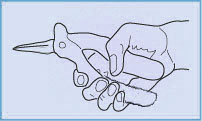
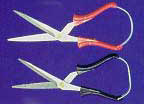
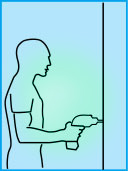
-
Use tools with handles that are long enough to span the entire hand. This design equalizes and spreads contact force across the entire palm and fingers and allows all fingers to provide force, which reduces the force by any single finger.
-
Use padded tool handles so there are no sharp edges that can press against the hand or fingers.
-
Use pneumatic or spring-loaded scissors with handles that extend across the palm and do not create contact trauma to the sides of the fingers.
-
Use power tools such as power screw drivers to perform tasks. These usually allow the hand to remain in a straight neutral posture and spreads contact stress across the entire hand.
-
Use padded gloves to protect the inside of the palm and the fingers.
Potential Hazard
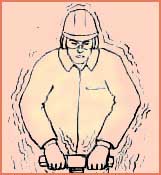
-
Repeated use of vibrating hand tools can damage blood vessels and reduce nutrient flow to the hand. Loss of circulation leaves fingers cold and numb and if continued for long periods can lead to tissue and nerve damage and hypersensitivity to cold. See Raynaud's Phenomenon.
Possible Solutions
-
Use vibration-dampening gloves.
-
Use handle coatings that suppress vibration.
-
Use vibration isolation between the attachment and tool to isolate vibration.
-
Avoid extended use of vibrating machinery, such as chain saws or pneumatic tools.
Tendons, muscles, and nerves of the elbow and forearm are stressed when employees must repetitively bend or rotate the lower arm. For example, activities that require forceful rotation of the forearms such as tennis can cause elbow pain. When the elbow comes in contact with hard work surfaces the nerves that run through the inner part of the elbow can be compressed causing pain or numbness in the ring and little fingers similar to when one strikes their "funny bone" on a hard surface.
Potential Hazard

-
Repeated bending of the elbow due to pulling levers, lifting, or working on a task that is too close to the body can lead to irritation of tendon-bone connections and nerves.
Possible Solutions
-
Consider alternative operation controls, such as foot pedals or joysticks, to replace pull levers.
-
Position most work so the arm can be maintained close to the body and the upper and lower arm are at about 90-120 degrees to each other.
Potential Hazard

-
Contact of the lower arm or elbow with hard or sharp surfaces can compress the ulnar nerve and may lead to tingling or numb fingers.
Possible Solutions

-
Pad the edge of work surfaces that come into contact with the elbow or forearm.
-
Arrange work tasks so the arm is not laying on the work surface
Potential Hazard

-
Tasks requiring repetitive twisting or rotation of the forearms, particularly when the wrist is bent, such as the motion used to drive screws using a manual driver can lead to irritation and pain around the elbow, commonly known as Epicondylitis, or Golfer's or Tennis elbow.
Possible Solutions

-
Eliminate repeated forearm rotation by using power tools such as electric screwdrivers.
-
Take breaks or rotate through tasks that do not involve repetitive pushing, pulling, and twisting.
-
Decrease the risk of injury when the forearm must be rotated by minimizing bending the wrist.

